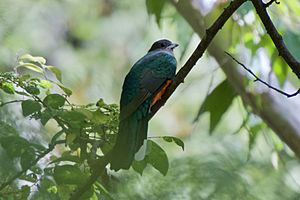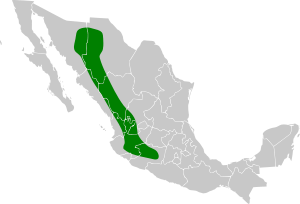Eared quetzal facts for kids
The eared quetzal (Euptilotis neoxenus), also called the eared trogon, is a beautiful bird belonging to the trogon family. It lives in the Sierra Madre Occidental mountains of Mexico, especially in pine and oak forests near streams and in canyons. Sometimes, this bird travels north and can be seen in southeastern Arizona in the United States, where it has even nested. This area includes parts of the Madrean Sky Islands, which are like isolated mountain "islands" in the desert.
Quick facts for kids Eared quetzal |
|
|---|---|
 |
|
| A male eared quetzal in the Chiricahua Mountains. | |
| Conservation status | |
| Scientific classification | |
| Genus: |
Euptilotis
|
| Species: |
neoxenus
|
 |
|
| Synonyms | |
|
Trogon neoxenus – protonym |
|
Contents
About the Eared Quetzal
What's in a Name?
The eared quetzal was first described in 1838 by an English bird expert named John Gould. He gave it the scientific name Trogon neoxenus. Later, in 1858, Gould decided this bird was special enough to have its own group, or genus, called Euptilotis. So, its full scientific name became Euptilotis neoxenus. It's the only species in the Euptilotis genus.
The name neoxenus comes from ancient Greek words. Neos means "new," and xenos means "stranger" or "visitor." The genus name Euptilotis also comes from Greek. Eu means "good," ptilon means "feather," and -ōtis means "eared." This refers to the wispy, feather-like tufts near its ears. This bird is a single species, meaning there are no different types or subspecies of eared quetzals.
Scientists have studied the bird's DNA to understand its family tree. In 2005, a study showed that the eared quetzal is closely related to the Pharomachrus genus, which includes other famous quetzals like the resplendent quetzal.
How to Spot an Eared Quetzal
Eared quetzals are about 33 to 36 centimeters (13 to 14 inches) long. Both male and female birds have shiny green backs and dark blue feathers in the middle of their tails. Their outer tail feathers are mostly white at the ends with a black band closer to their bodies. Females might have some black and white stripes on these feathers. Their beaks are dull gray with a slightly darker tip.
The adult male has a black head, a shiny green chest, and a bright red belly. The adult female has a gray head, chest, and upper belly, with a smaller but still bright red area on her lower belly. Both males and females have special wispy, hair-like feathers around their ears, which is how they got their name. However, these feathers are often hard to see when you spot the bird in the wild. Compared to other trogons, their heads and beaks look quite small and narrow.
The male's song is a series of whistles that get louder, sounding like a tremolo. They also make other sounds, like soft squeals that rise in pitch, a loud squeal ending with a sharp "chuck," and a harsh cackle, especially when flying.
Quetzals are different from typical New World trogons in a few ways. Their wing feathers are shiny, and their two front toes are not as strongly joined together. They also have wide tails that curve outwards, unlike the straight or inward-curving tails of other trogons. Their eggs are pale blue. Quetzals are generally larger than other trogons, and their eggs and young take longer to develop. The eared quetzal is considered a more basic type of quetzal because it doesn't have the super long, shiny tail and wing feathers seen in other Pharomachrus quetzals, like the famous resplendent quetzal.
Where Do They Live?
Eared quetzals live in the middle and upper parts of forests. They prefer pine-oak woodlands and oak-conifer forests, often found near streams. They stay in these areas all year round.
Eared Quetzal Life
Nesting and Reproduction
Eared quetzals build their nests in shallow holes inside trees, usually 5 to 9 meters (16 to 30 feet) high. They often choose old holes made by woodpeckers. They don't line their nests with anything. They have been seen nesting in pine, fir, maple, and aspen trees. They use their beaks to dig a little more into the soft, rotten wood inside the cavity to make it just right.
What Do They Eat?
Eared quetzals eat a variety of foods, including insects, small vertebrates (like small lizards), and fruit. They especially like the bumpy red fruits of madrone trees. They feed their young caterpillars, moths, katydids, cicadas, and other small creatures. Like other trogons, eared quetzals often grab their food, whether it's an insect or a fruit, while hovering in the air.
See also
 In Spanish: Surucuá silbador para niños
In Spanish: Surucuá silbador para niños


